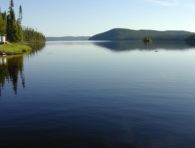It is a known fact that trolling enables one to cover much water in little time compared to casting. It is thus normal for trolling to become one’s choice approach when it comes to exploring new or very large lakes. Once a few structures have shown some fish activity, it is possible for one to stop and start a more complete coverage of the spot using other techniques.
This is precisely the kind of experience that awaits you upon your first visit on Lake Maupertuis. And as I was myself somewhat intimidated by this immense water body and its submarine cliffs upon my first outing, I thought it a good idea to share my findings with you in an attempt to allow you to get better prepared.
Underwater structures on Lake Maupertuis, which are often impossible to evaluate by relying on the surrounding above-surface topography, are literally submarine mountains. One moves from a depth of 100 feet to one of 4 feet by moving very little with the boat and this, right in the middle of nowhere. It is precisely on such underwater cliffs that one can find some of the largest predators in the ecosystem. All such predators have to do is to stay put, just at the right depth where they find their preferential water temperature of 52 to 58 degrees F. When they get hungry, they swim toward the surface, eat and immediately return to the comfort zone, having made a minimal effort.
It is therefore essential to make trolling a priority in an attempt to locate such abrupt structures, and as I do so, I clearly tend to favor very large lures as they are more easily detected by predatory fish on such large structures. However, using giant spoons such as #60 and 70 Williams Wablers or #70 and 80 Williams Whitefish is almost impossible with a 6 or 8 pound monofilament that one would perhaps be tempted to use on more traditional water bodies. You need not leave this type of equipment at home upon your departure for Aventures Nipissi as you will be able to use it in the smaller lakes and rivers of the territory. On the other hand, be sure to bring a rod whose purpose will be specifically to troll in such special conditions.
Now that you know the typical size of some of the lures that may be most productive on Lake Maupertuis, let me explain what tackle should come with them.
The rod: It goes without saying that it should be stiff enough to offer resistance to the lure and make the latter move. It must not be fully flexed by the lure’s weight and pull alone, even before a fish bites. A medium-fast action is perfect, but this kind of technical jargon lacks precision in a market where rod builders never seem to agree to standardize such expressions and their meaning. Take a look at the rod’s
characteristics and the recommended lure weight, some information you will find close to the rod’s handle. It is always better to have a rod that is slightly above the needs than the opposite.
The line: Trolling accelerates line twist. This is even more true when it comes to large lures, for their weight and the pull they have on the line stretch the latter irrevocably. Once the line has been fully stretched, it twists. It is therefore essential to use the line with the least elasticity you can find, and here braided lines outfish all others. Powerpro Superslick 8 and Fireline are good choices as well as other brands. Just be sure to check the line’s elasticity and choose your trolling line accordingly.
Swivels: These are the underdogs of the tackle industry. The market offers a multitude of choices whose prices range from about $3 per dozen to about $2 per swivel. Of course, swivels do not possess the appeal that shiny and fluorescent lures have, and thus we are often inclined not to invest much money in this essential item. Cheap brass and nickel spring swivels only reduce line twist by about 10 to 30%, which makes them useless. Ball bearing swivels have a better performance as they reduce twist by 50 to 80% depending on their quality. They are then to be seen as an investment. And as regards quantity, remember that because of the large lures you will be trolling with, you will need to have one swivel at each end of the spoon to maximize their efficiency. Hence you really cannot have too many of them in your tackle box. On the upside, the type of structure you will find on Lake Maupertuis does not lead to much loss of tackle.
The snelled hook: Here I like to have 18 inches of line between the lure and the bait. President-type hooks are thus perfect. However, in warmer water or else when the fish are finicky, I prolong that distance to 24 inches or more. This is where Gamakatsu hooks shine. They are made without a loop at the lure end, so it is easy to cut them to the appropriate length. And in extreme conditions where I choose to increase the distance between the spoon and the bait even further, I always keep a package of hooks and a spool of line to make whatever is best in the circumstances.
As far as lures go, although I have clearly expressed my appreciation for Williams lures above, do not let this prevent you from using your own favorites, provided they respect the rule of thumb: they must be large!
Patrick Savard
 Téléphone // 450 669-8239 // 514 708-5261
Téléphone // 450 669-8239 // 514 708-5261 Comment s’y rendre
Comment s’y rendre
